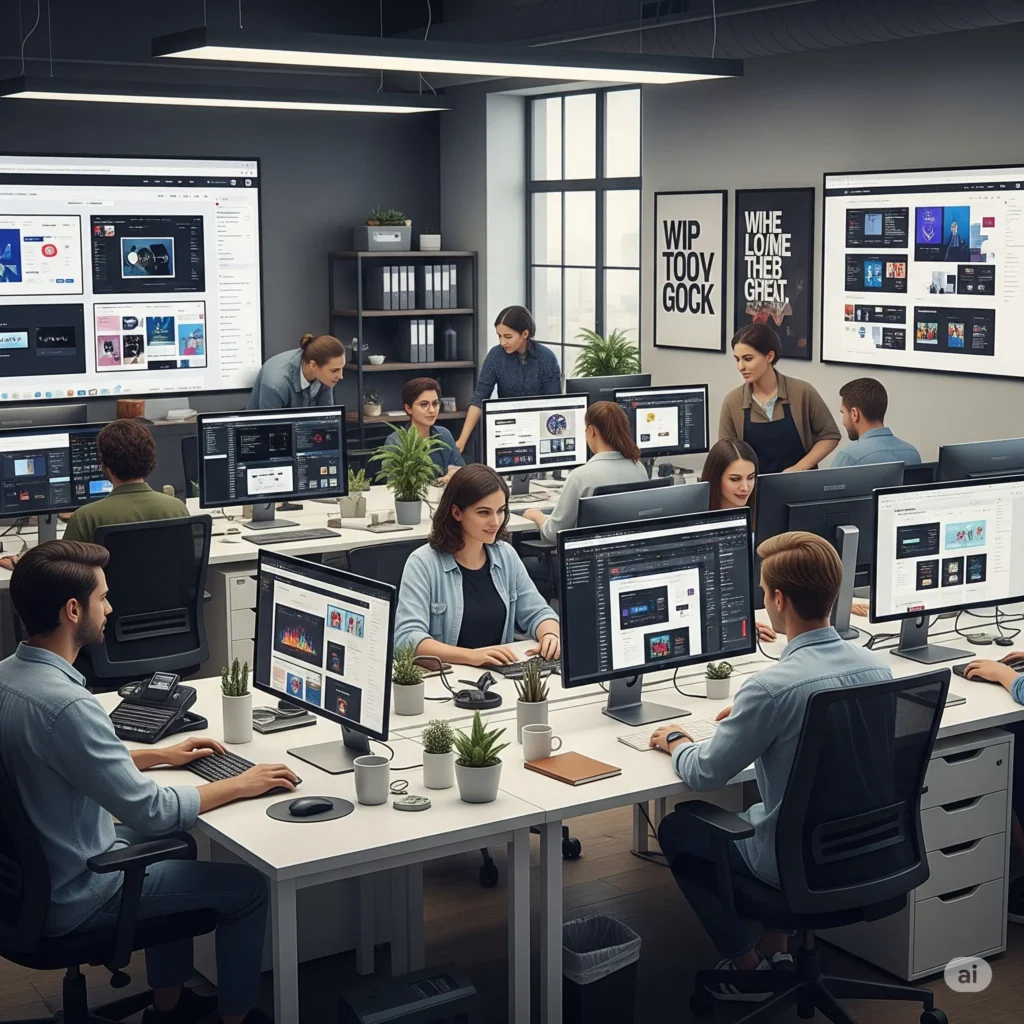In today’s hyper-connected world, your website isn’t just an online brochure; it’s your digital storefront, your communication hub, and often, the first impression you make. To truly thrive, businesses and individuals alike need a website that is not only visually stunning but also highly functional, user-friendly, and optimized for search engines. This is where the powerful synergy of web design and web development comes into play.
Gone are the days of static, one-size-fits-all websites. The digital landscape is constantly evolving, with new technologies and user expectations emerging at lightning speed. Understanding the latest web development trends and modern web design principles is no longer optional – it’s essential for building high-ranking websites that captivate audiences and drive results.
The Art of Web Design: More Than Just Aesthetics
Web design is the creative process of planning and creating the visual and interactive elements of a website. It’s about shaping the user experience (UX) and user interface (UI) to be intuitive, engaging, and reflective of a brand’s identity. A well-designed website isn’t just pretty; it’s a strategic asset that guides visitors, builds trust, and converts leads.
Key elements of modern web design include:
- Responsive Web Design: This is non-negotiable in 2025. With users accessing websites on a myriad of devices – from smartphones and tablets to desktops and smart TVs – a responsive website fluidly adapts its layout and content to fit any screen size. This “mobile-first approach” ensures an optimal viewing and interaction experience for everyone, regardless of their device. Think fluid grids, flexible images, and media queries that dynamically adjust content.
- Intuitive UI/UX Design Principles: User Interface (UI) design focuses on the visual elements users interact with (buttons, menus, typography, color schemes), while User Experience (UX) design is the broader concept of how a user feels when interacting with your site. A seamless UX means easy navigation, clear calls to action, and a logical flow that anticipates user needs. Investing in UI/UX design dramatically increases user engagement, reduces bounce rates, and directly impacts conversions.
- Visual Hierarchy and Minimalism: Modern design embraces clarity. By using ample white space, bold typography, and strategic visual elements like hero images and well-placed calls to action, designers create a clear hierarchy that guides the user’s eye to the most important information. Minimalism removes clutter, making the site feel clean, professional, and easy to digest.
- Accessibility: An often-overlooked but crucial aspect, website accessibility ensures your site is usable by people with disabilities. This includes proper alt text for images, keyboard navigation, and adequate color contrast. An accessible website is inclusive and broadens your audience reach.
The Science of Web Development: Bringing Designs to Life
If web design is the blueprint, web development is the construction crew. It’s the coding and programming work that makes a website functional and interactive. This vast field can be broadly categorized into two main areas: front-end development and back-end development.
- Front-End Development: This is what users directly see and interact with in their browser. Front-end developers use languages like HTML (for structuring content), CSS (for styling and layout), and JavaScript (for interactivity and dynamic behavior). Popular JavaScript frameworks like React, Angular, and Vue.js streamline the process of building complex and engaging user interfaces. They ensure cross-browser compatibility and optimize the visual performance of the website.
- Back-End Development: This involves the “behind-the-scenes” logic, servers, databases, and APIs that power the website’s functionality. Back-end developers work with languages such as Python, Java, Node.js, PHP, and Ruby. They manage data storage, user authentication, security, and ensure seamless communication between the client-side (front-end) and the server. Think of it as the engine and infrastructure that make the beautiful car (front-end) actually run.
- Full-Stack Development: A full-stack developer possesses skills in both front-end and back-end development, capable of building a complete web application from start to finish. This versatility is highly valued in the industry.
Beyond the Basics: Crucial Factors for a High-Ranking Website
To ensure your website not only looks good but also gets found by your target audience, integrating Search Engine Optimization (SEO) best practices from the outset is paramount.
- Technical SEO: This involves optimizing the technical aspects of your website to help search engines crawl and index it more effectively. Key elements include:
- Website Speed Optimization: Google heavily prioritizes fast-loading websites. Techniques like image compression, lazy loading, minimizing HTTP requests, leveraging browser caching, and using Content Delivery Networks (CDNs) significantly improve website performance. Core Web Vitals (Largest Contentful Paint, First Input Delay, Cumulative Layout Shift) are crucial metrics to monitor.
- Clean URL Structure: Descriptive, simple, and keyword-rich URLs are easier for both users and search engines to understand.
- XML Sitemaps: Submitting an XML sitemap to Google Search Console helps search engines discover and index all your important pages.
- Robots.txt: This file tells search engine crawlers which pages or sections of your site they should or shouldn’t access.
- SSL Certificates: Having an HTTPS website (secured by an SSL certificate) is a fundamental security measure and a minor ranking factor.
- Structured Data (Schema Markup): Implementing schema markup helps search engines understand the content of your pages, potentially leading to rich snippets in search results and increased visibility.
- On-Page SEO: This refers to optimizations within your website’s content and HTML source code.
- Keyword Research: Identifying high-ranking keywords relevant to your content and audience is the foundation. Integrate these naturally throughout your content.
- Compelling Title Tags & Meta Descriptions: These snippets appear in search results and influence click-through rates. Make them enticing and include keywords.
- Proper Header Tags (H1, H2, H3): Use header tags to structure your content logically, making it readable for users and understandable for search engines.
- High-Quality, Engaging Content: “Content is king.” Provide valuable, informative, and original content that answers user questions and establishes your authority. Regular content updates signal to search engines that your site is active and relevant.
- Image Optimization: Beyond compression, use descriptive file names and accurate
altattributes for all images.
- Off-Page SEO: Activities outside your website that influence its ranking.
- Backlinks: Quality backlinks from authoritative websites act as “votes of confidence” and are a strong ranking signal.
- Social Media Engagement: While not a direct ranking factor, a strong social presence can drive traffic and increase brand visibility.
The Future of Web: Emerging Trends in 2025
The world of web design and development is dynamic. Keeping an eye on future trends is crucial for staying ahead of the curve. Expect to see continued growth in:
- AI Integration: Artificial intelligence will play an even larger role, from AI-powered design tools and automated content generation to enhanced personalized user experiences and intelligent chatbots.
- Progressive Web Apps (PWAs): Blurring the lines between websites and native mobile apps, PWAs offer offline capabilities, push notifications, and faster loading times, providing an app-like experience directly from the browser.
- Voice Search Optimization: With the rise of smart assistants, optimizing your content for conversational queries will become increasingly important.
- No-Code/Low-Code Platforms: These platforms empower non-developers to create functional websites and applications with minimal coding, democratizing web creation.
- Enhanced Interactivity and Immersive Experiences: Microinteractions, animated charts, and immersive scrolling experiences will continue to make websites more dynamic and engaging.
- Cybersecurity: As websites become more complex and store more sensitive data, robust cybersecurity measures will remain a top priority.
Conclusion: Your Digital Journey Starts Here
Building a successful online presence in 2025 requires a holistic approach that seamlessly blends the artistry of web design with the technical prowess of web development. By prioritizing responsive design, intuitive UI/UX, robust SEO strategies, and staying abreast of emerging web development trends, you can create a digital masterpiece that not only attracts visitors but also converts them into loyal customers.
Whether you’re a small business looking to establish your first online footprint or a large enterprise aiming to enhance your digital presence, investing in professional web design and development services is an investment in your future. It’s about crafting a digital experience that resonates with your audience, stands out from the competition, and ultimately, drives your success in the ever-evolving online world.



